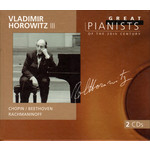
MARBECKS COLLECTABLE: Great Pianists of the 20th Century - Vladimir Horowitz
 $35.00
Low Stock
add to cart
$35.00
Low Stock
add to cart
VARIOUS COMPOSER TRANSCRIPTIONS
MARBECKS COLLECTABLE: Great Pianists of the 20th Century - Vladimir Horowitz
Vladimir Horowitz (piano)
[ Philips / EMI / 2 CD ]
Release Date: Friday 1 October 1999
Should this item be out of stock at the time of your order, we would expect to be able to supply it to you within 2 - 4 weeks.
Horowitz was born in Kiev, which was a part of the Russian Empire at the time, to a Jewish family in 1903. He was the youngest of four children. His father was an engineer and his mother was a pianist. He first started piano lessons from his mother at an early age. In 1912 he joined Kiev University where he was taught by Vladimir Puchalsky, Sergei Tarnowsky, and Felix Blumenfeld. He performed Sergei Rachmaninoff's Piano Concerto No. 3 in D Minor on his graduation. He then performed his first solo concert in Kharkiv in 1920.
Horowitz got more and more famous but was often paid in food rather than money because Russia wasn't very rich. Although performing in many concerts, he secretly wanted to be a composer. In 1925, he moved to the West, intending not to return.
Horowitz was most well known for playing music written between 1830 and 1920. His 1932 recording of the Liszt Sonata is still considered by many to be the best ever, even though many other pianists have recorded it. Other pieces he was famous for were Scriabin's Étude in D-sharp minor, Chopin's Ballade No. 1 in G minor, and many of Rachmaninoff's short pieces, including Polka de W.R. Horowitz was praised for his way of playing the Rachmaninoff Piano Concerto No. 3, and the composer said "he swallowed it whole. He had the courage, the intensity, the daring." Horowitz later became good friends with Rachmaninoff. Horowitz was also well known for playing quieter works like Schumann's Scenes of Childhood, Scarlatti sonatas, and some Mozart and Haydn sonatas.
Horowitz's way of playing often used large contrasts between soft and loud volumes. He was able to play louder than most other pianists, without making an ugly sound. His playing was also known for many different kinds of sounds - sometimes called tone colors. Horowitz was also famous for playing precise passages in octaves very fast.
Tracks:
Frédéric Chopin
1-1 Barcarolle In F Sharp, Op. 60, B 158
8:40
1-2 Mazurka No. 21 In C Sharp Minor, Op. 30 No. 4
3:37
1-3 Mazurka No. 7 In F Minor, Op. 7 No. 3, CT 57
2:21
1-4 Mazurka No. 27 In E Minor, Op. 41 No. 2, CT 77
1:53
1-5 Mazurka No. 32 In C Sharp Minor, Op. 50 No. 3, CT 82
4:13
1-6 Etude No. 4 In C Sharp Minor, Op. 10 No. 4, CT 17
2:00
1-7 Etude No. 5 In G Flat, Op. 10 No. 5, CT 18 "Black Keys"
1:33
1-8 Etude No. 8 In F, Op. 10 No. 8, CT 21
2:19
1-9 Etude No. 15 In F, Op. 25 No. 3, CT 28
1:29
1-10 Etude No. 3 In E, Op. 10 No. 3, CT 16 "Tristesse"
4:01
1-11 Etude No. 4 In C Sharp Minor, Op. 10 No. 4, CT 17
2:01
1-12 Etude No. 19 In C Sharp, Op. 25 No. 7, CT 32
5:22
1-13 Etude No. 5 In G Flat, Op. 10 No. 5, CT 18 "Black Keys"
1:43
1-14 Mazurka No. 17 In B Flat Minor, Op. 24 No. 4, CT 67
4:28
1-15 Mazurka No. 19 In B Minor, Op. 30 No. 2, CT 69
1:45
1-16 Mazurka No. 21 In C Sharp Minor, Op. 30 No. 4
2:43
1-17 Mazurka No. 20 In D Flat, Op. 30 No. 3, CT 70
2:57
1-18 Mazurka No. 38 In F Sharp Minor, Op. 59 No. 3
3:06
1-19 Mazurka No. 26 In C Sharp Minor, Op. 41 No. 1, CT 76
3:05
1-20 Mazurka No. 32 In C Sharp Minor, Op. 50 No. 3, CT 82
4:49
1-21 Mazurka No. 7 In F Minor, Op. 7 No. 3, CT 57
2:17
1-22 Mazurka No. 41 In C Sharp Minor, Op. 63 No. 3, CT 91
1:58
1-23 Mazurka No. 40 In F Minor, Op. 63 No. 2
1:41
1-24 Polonaise No. 6 In A Flat, Op. 53 "Héroïque"
5:57
Ludwig van Beethoven
Piano Concerto No. 5 In E Flat, Op. 73 "Emperor"
2-1 1. Allegro 18:57
2-2 2. Adagio Un Poco Mosso 8:30
2-3 3. Rondo. Allegro 9:37
Sergei Rachmaninoff
Piano Concerto #3 In D Minor, Op. 30
2-4 1. Allegro Ma Non Tanto 15:20
2-5 2. Intermezzo. Adagio 9:47
2-6 3. Finale. Alla Breve 12:09